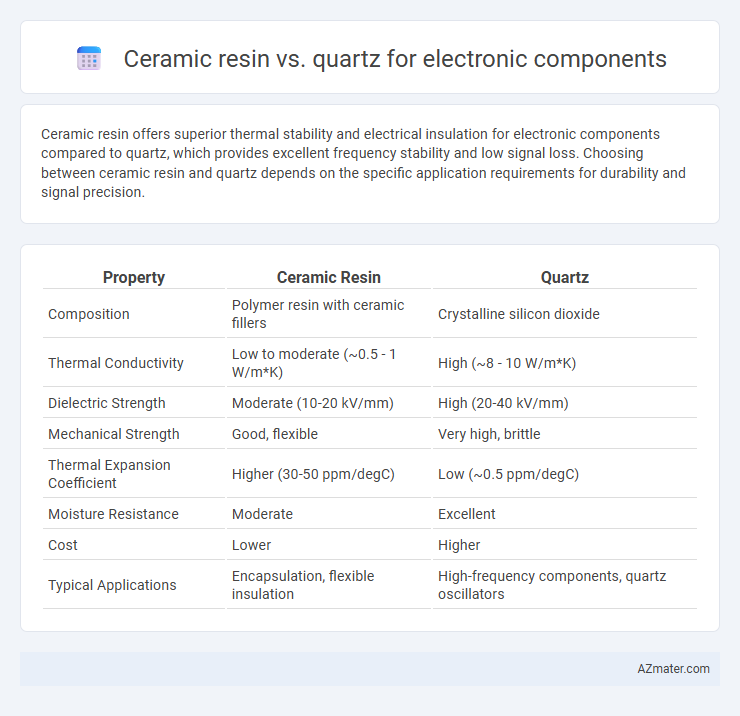Ceramic resin offers superior thermal stability and electrical insulation for electronic components compared to quartz, which provides excellent frequency stability and low signal loss. Choosing between ceramic resin and quartz depends on the specific application requirements for durability and signal precision.
Table of Comparison
| Property | Ceramic Resin | Quartz |
|---|---|---|
| Composition | Polymer resin with ceramic fillers | Crystalline silicon dioxide |
| Thermal Conductivity | Low to moderate (~0.5 - 1 W/m*K) | High (~8 - 10 W/m*K) |
| Dielectric Strength | Moderate (10-20 kV/mm) | High (20-40 kV/mm) |
| Mechanical Strength | Good, flexible | Very high, brittle |
| Thermal Expansion Coefficient | Higher (30-50 ppm/degC) | Low (~0.5 ppm/degC) |
| Moisture Resistance | Moderate | Excellent |
| Cost | Lower | Higher |
| Typical Applications | Encapsulation, flexible insulation | High-frequency components, quartz oscillators |
Introduction to Ceramic Resin and Quartz in Electronics
Ceramic resin and quartz are essential materials in electronics, each offering unique properties for component manufacturing. Ceramic resin provides excellent thermal stability, electrical insulation, and mechanical strength, making it ideal for encapsulating and protecting sensitive electronic parts. Quartz is prized for its piezoelectric properties and high-frequency resonance, widely used in oscillators and timing devices for precise signal control.
Material Composition and Structure Comparison
Ceramic resin in electronic components is typically composed of polymer matrices combined with ceramic fillers, offering flexibility and lightweight characteristics, while quartz consists of pure crystalline silicon dioxide known for its exceptional hardness and thermal stability. The amorphous structure of ceramic resin allows for better shock absorption and insulation properties, contrasting with the highly ordered lattice structure of quartz that provides superior piezoelectric and frequency control capabilities. Material composition influences the choice in applications; ceramic resin suits encapsulation and insulation roles whereas quartz excels in precision timing and oscillation functions.
Electrical Insulation Properties
Ceramic resin exhibits superior electrical insulation properties due to its high dielectric strength and low dielectric constant, making it ideal for high-frequency electronic components. Quartz, while also an excellent insulator, offers exceptional thermal stability and low dielectric loss, which is critical in precision oscillators and timing devices. The choice between ceramic resin and quartz depends on the specific electrical insulation requirements, operating temperature, and frequency range of the electronic component.
Thermal Conductivity and Heat Resistance
Ceramic resin offers moderate thermal conductivity around 1-3 W/mK, providing good insulation but limited heat dissipation, while quartz exhibits higher thermal conductivity approximately 6 W/mK, enabling efficient heat transfer in electronic components. In terms of heat resistance, ceramic resin withstands temperatures up to 200-300degC, suitable for most standard applications, whereas quartz maintains stability beyond 1000degC, making it ideal for high-temperature environments. The superior thermal performance and heat resistance of quartz contribute to enhanced reliability and longevity in advanced electronic devices.
Mechanical Strength and Durability
Ceramic resin offers superior mechanical strength with high resistance to wear and thermal shock, making it ideal for electronic components subjected to harsh conditions. Quartz excels in durability due to its exceptional hardness and stability under extreme temperatures, ensuring long-term performance in precision applications. Both materials provide robust solutions, but ceramic resin often delivers enhanced impact resistance, while quartz emphasizes chemical inertness and minimal thermal expansion.
Chemical Stability and Environmental Resistance
Ceramic resin offers superior chemical stability compared to quartz, exhibiting excellent resistance to acids, alkalis, and solvents commonly encountered in electronic manufacturing environments. Quartz, while possessing inherent hardness and thermal stability, is more susceptible to chemical attack under harsh conditions, especially from hydrofluoric acid and strong alkaline solutions. The environmental resistance of ceramic resin also surpasses quartz due to its enhanced ability to withstand moisture, temperature fluctuations, and mechanical stresses without degrading or losing electrical insulation properties.
Cost Efficiency and Material Availability
Ceramic resin offers cost efficiency in electronic components due to lower raw material and manufacturing expenses compared to quartz, making it a preferred choice for budget-sensitive applications. Quartz provides superior material availability and consistency, benefiting high-performance electronics requiring stable thermal and electrical properties. The decision between ceramic resin and quartz hinges on balancing upfront costs with long-term reliability and material supply stability.
Applications in Electronic Components
Ceramic resin offers excellent thermal stability and electrical insulation, making it ideal for high-frequency capacitor substrates and insulating layers in electronic components. Quartz is preferred for its exceptional piezoelectric properties, enabling precise oscillators and resonators in timing devices and filters. Both materials provide unique benefits in electronic applications, with ceramic resin excelling in insulation and thermal management, while quartz delivers superior frequency control and signal stability.
Manufacturing Processes and Scalability
Ceramic resin offers precise molding capabilities with low-temperature curing, enabling efficient batch production ideal for complex electronic components, while quartz requires high-temperature processing and precise cutting, which can limit scalability due to energy consumption and machining time. The versatility of ceramic resin allows rapid prototyping and easier integration into automated manufacturing lines, whereas quartz's brittleness and rigidity demand careful handling and specialized equipment, complicating large-scale fabrication. Scalability in manufacturing favors ceramic resin for cost-effective volume production, whereas quartz remains preferred for applications needing superior thermal stability despite higher production constraints.
Future Trends and Innovations in Material Selection
Ceramic resin and quartz are pivotal materials in electronic components, with future trends emphasizing enhanced thermal stability and electrical insulation for high-frequency applications. Innovations focus on hybrid composites combining ceramic resin's flexibility with quartz's superior dielectric properties to improve performance in miniaturized devices. Emerging smart materials incorporating nanotechnology aim to optimize conductivity and durability, driving advancements in flexible electronics and next-generation semiconductors.

Infographic: Ceramic resin vs Quartz for Electronic component
 azmater.com
azmater.com